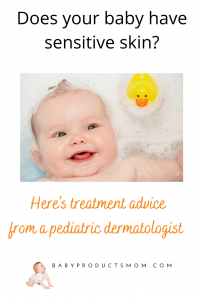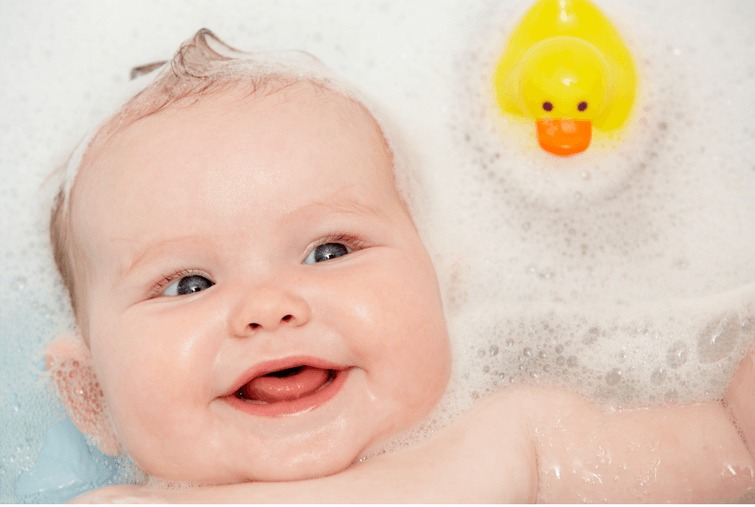 Right up there with puppies, kittens, crimson sunsets, shared laughter—and other great things in life–is newborn baby skin. It doesn’t last forever. But when it’s here, you can’t help but marvel at the miracle of its pillowy lushiness.
Right up there with puppies, kittens, crimson sunsets, shared laughter—and other great things in life–is newborn baby skin. It doesn’t last forever. But when it’s here, you can’t help but marvel at the miracle of its pillowy lushiness.
“Baby’s skin should feel wonderful,” says Sheilagh Maguiness, MD, a pediatric dermatologist at the University of Minnesota Health Pediatric Specialty Care Discovery Clinic and spokesperson for the Society for Pediatric Dermatology. Soft and smooth baby skin is a sign the skin barrier is working.
But what if your baby’s newborn skin has crusty patches? Or it’s drier than the Sahara? What is the skin barrier?
Read on for some baby sensitive skin care information that might change the way you handle baby bath time–otherwise known as that wet and wiggly bonding session.
Note: This post contains affiliate links. BPM only promotes certain products and services she believes to be of high quality and value that can be beneficial to you. Thank you for your support, which continues to make this blog possible.
What is the skin barrier?
Ok, first–the outside story. The skin barrier is the surface of the skin—the stratum corneum. It’s your baby’s birthday suit and it has a big job to do, including keeping out stuff that shouldn’t get in, like allergens and harmful bacteria. Water and oils naturally evaporate from skin’s surface.
We’re all always losing water and oils from our skin all the time. But a healthy skin barrier–stratum corneum–can also help keep your baby’s skin hydrated by preventing water and oils from skedaddling from the skin’s surface too quickly.
If your baby’s skin feels a little dry or you’re seeing cradle cap—crusty or oil patches on your baby’s scalp–or if your newborn has diaper rashes or baby acne, that’s a sign the skin barrier isn’t perfect. “Skin barrier defects are the cause of dry skin and atopic dermatitis (eczema) in 70% to 80% of pediatric patients,” Dr. Maguiness says.
The result? Red, itchy and inflamed baby sensitive skin.
Why is my baby’s skin so sensitive?
Dry, baby sensitive skin happens when baby’s skin doesn’t retain water in that top layer, the stratum corneum. Babies with eczema (atopic dermatis), for example, develop it because they’re missing filaggrin–a protein in the top layer of the skin.
“When you don’t have enough filaggrin, you’ll lose more water through the skin than normal,” Dr. Maguiness says. Eczema tends runs in families. Children who come from families with a history of eczema, asthma or hay fever (known as the atopic triad) are more likely to develop eczema. If your baby inherited the tendency for eczema, something in the environment then triggers it.
Overall, “20% of babies are going to have dry skin/eczema,” Dr. Maguiness says. “That can start right in the newborn period. At around three months of age, you can start to see those signs of dry skin.”
How do I get rid of dry, irritated baby skin?
Fortunately, skin barrier defects like eczema can be easily treated at home. To take the very best care of your newborn baby’s dry, sensitive skin, Dr. Maguiness offers these skincare tips.
1. Bathe your baby daily

How often should you bathe your newborn? It depends. “Babies with normal skin, those who aren’t showing any sign of sensitive skin and don’t have a family history of eczema, you can probably get away with bathing them two or three times a week. And you probably don’t even need to apply a moisturizer,” Dr. Maguiness says.
“But children with dry, sensitive skin need to be bathed every day,” Dr. Maguiness says. And don’t think a sponge bath will do it.
2. Soak it up
You know that pruney look you get when you’ve had a good soak in the bathtub? That’s the look you’re going for with your baby at bath time.
“That’s water expanding the stratum corneum,” Dr. Maguiness says. “It’s all about getting the water in.” During your baby’s daily bath, a good soaking can help prevent eczema-prone skin from drying out.
Your baby’s skin is like a sponge. Completely saturating your baby’s skin in water adds water back to your baby’s top later of skin (yes–the stratum corneum), which helps keep it soft and supple.
Best Baby Bathtubs for Babies with Dry Skin
If your baby has sensitive skin, these soaker tub can help get the job done!
Boon Soak

Munchin Sit and Soak Baby Bathtub
“If your baby has dry skin or eczema runs in my family, buy a baby bathtub with more volume of water for a true immersion tub bath,” Dr. Maguiness says.
Saturating baby sensitive skin with water is easier to do when you’ve got the right infant bathtub. The sling type of bathtub is just fine for babies with not-sensitive skin.
But the best tub for a newborn with dry, sensitive skin is a baby bathtub that allows you to immerse your baby’s body in lukewarm water, Dr. Maguiness says.
Of course, you’re not going to dunk your baby’s head in the water. But you do want a baby bathtub deep enough to easily get water on your baby’s face and scalp.
Safety note: Never leave your baby alone in the bathtub for even just a minute–not to run for your cellphone, answer the door or get something from the other room. According to the Consumer Product Safety Commission, children can drown in even a very small amount of water.
3. Skip the soap for baby sensitive skin
“You don’t need any soap. Water is a perfectly good cleansing solvent. Soapy bubbles and foam can be drying,” Dr. Maguiness says.
Still, a very gentle liquid nondetergent or non soap cleanser is fine in the first three months as long as you’re just cleaning the dirty parts, such as the diaper area, the armpits and hair. But you don’t need to lather your baby up all over with tons of foam.
Good choices for nonsoap body washes for babies are bland, fragrance-free, and often marked with hypoallergenic on the label, Dr. Maguiness says. Some options fitting her criteria include Cetaphil and Vanicream.
4. Smear on moisturizer for baby sensitive skin
Within 30 to 60 seconds of taking your pruney baby out of the baby bathtub, dry him/her off and massage a thick emollient moisturizer into your baby’s skin to seal in the water. “My favorite moisturizer is just plain petroleum jelly, something that is really thick and greasy. You want it to lock that water in,” Dr. Maguiness says. Vaseline petroleum jelly or Aquaphor fit the bill.
Stay away from lotions. “Pump lotions have high alcohol content; they often have fragrance and a lot of additives. You’re putting things on you don’t really need to and it’s not going to trap the water.”
How long do you need to keep up the daily bath, soak and smear routine? Studies show that applying a daily bland moisturizer can reduce the signs and symptoms of eczema by up to 50% at six months.
As a rule of thumb, keep up the soak and smear routine for the first six to eight months. “It’s very protective, it’s safe, it’s cost effective and if your child’s skin feels normal and isn’t super sensitive, you could certainly reduce at that point,” Dr. Maguiness says.
If your baby still has ongoing signs and symptoms of eczema, keep up the soak and smear routine and the nightly bath.
Should you change your baby’s skincare routine in the winter versus the spring and summer?
Nope. “Certainly in winter and dry cold climates, your baby is more prone to having dry skin, and that’s when children predisposed to eczema might flare,” Dr. Maguiness says. But you can stick to the same baby skincare routine year round.
Products to Avoid for Baby Sensitive Skin
In general, stay away from baby skincare products with fragrance, essential oils and surfactants (foaming agents). “Applying fragrance so early on could actually sensitize the baby,” Dr. Maquiness says.
Think fragrance free, very bland and and thick.
“I’ve seen a lot of kids with eczema induced by Johnson and Johnson’s body wash,” she says. “It’s so drying.” The number two ingredient is cocoamidopropyl betaine, which is a surfactant.
“Cocoamidopropyl betaine is super drying,” Dr. Maguiness says.
Shop Amazon – Create an Amazon Baby Registry
Why is baby skincare so important?
Not only does the right skincare routine help keep your baby comfortable and baby skin soft and smooth, it makes your baby less prone to food allergies.
Consider: Chronic eczema in infancy can leave the skin barrier dry and “leaky,” Dr. Macquiness says, which means that allergens–proteins from food–could enter through the skin.

To reduce your baby’s risk of food allergy, talk to your pediatrician about introducing peanut-containing products such as Love that Peanut as early as four months of age.
Introducing peanut allergens to your baby’s immune system early through your baby’s diet may reduce your baby’s risk of food allergies.
If you wait to introduce peanut-containing products and your baby has eczema, peanut protein could enter through the skin, which may cause an allergic reaction.
Myth: Using a humidifier in dry environments can help keep eczema from flaring up.
Reality check: A humidifier isn’t helpful for eczema. “There’s not enough water in the air to get it in the stratum corneum,” Dr. Maquiness says.
“Baby skin really needs to be a soaking in the bathtub. That’s where your baby’s skin will pick up water and keep it in there.”
BabyProductsMom bottomline:
If your baby has eczema or your baby is still a bun in the oven but eczema, asthma or hay fever runs in your family, consider registering for or buying a soaker tub.
Pin it!








Türkçe Dublaj 1080p kalitesinde full hd film izleme sitesi. Türkçe dublaj filmlerimiz 1080p kalitesinde sizlerle. En h?zl? serverlarda yüklü vaziyette. Mary Gauani